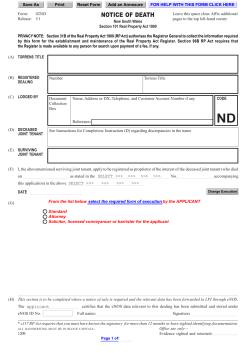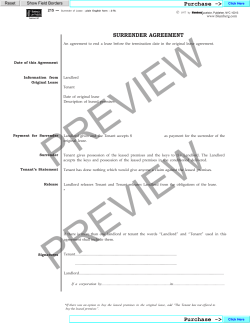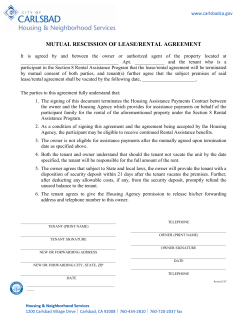
It's all relative - This article was first published in Property
Leasehold enfranchisement It’s all relative The Upper Tribunal has recently favoured a more conventional way of working out marriage value for the purposes of an enfranchisement claim. Natasha Rees examines the consequences H Natasha Rees is a partner and head of property litigation at Forsters edonic regression is not the usual topic of conversation among property lawyers and surveyors but it has caused something of a stir in the world of enfranchisement. In a recent decision of the Upper Tribunal in an appeal known as Kosta v Carnwath [2014], the tenant relied on a hedonic regression model in determining one of the few remaining areas of contention between enfranchisement surveyors: relativity. The appeal is of interest because the new model for calculating relativity resulted in a higher relativity than the more traditional method of relying on graphs of relativity. A higher relativity, in turn, results in a lower premium, which obviously suited the appellant tenant. It is also an area where there is no leading case that settles how relativity should be calculated. The tribunal in this case were not persuaded to depart from the traditional method adopted by the landlord and concluded that the profession at large has, thus far, failed to find a settled position on relativities for leasehold properties. The facts ‘Over the years valuers, with experience of the market, have developed relativity graphs based on tribunal decisions and settlement evidence.’ 26 Property Law Journal The claim concerned a house known as 47 Phillimore Gardens. The tenant owned a lease of the house, which, at the valuation date of 13 October 2011, had 52.45 years left to run. The tenant served notice on its landlord, the Phillimore Estate, seeking to acquire the freehold of the house pursuant to the Leasehold Reform Act 1967. Since the lease had less than 80 years left to run, the compensation payable under the Act included an element of what is known as ‘marriage value’. The tenant had to pay half of the marriage value as part of the compensation payable under the Act. Marriage value Marriage value is a concept that assumes that the value of the house after merging the leasehold and freehold interest is likely to be worth more than the sum of each part individually. This uplift in value is known as the marriage value. In calculating marriage value, the conventional approach, and one agreed by the parties before the Upper Tribunal, is to start with the value of the freehold of the house with vacant possession and then work out what proportion of that value the remaining lease should be. One would expect a very long lease to be worth almost as much as a freehold and a very short lease to be worth much less. This proportion or percentage is known as the relativity. The tenant in this case was arguing for a relativity of 87.04% and the landlord 75.5%. A higher relativity leads to a lower marriage value and thus less to pay for the freehold. The difference added almost a million pounds to the premium. One other complexity introduced by the 1967 Act is the fact that the valuation has to be carried out in a so-called ‘no-Act world’. This is based on the wording of s9(1A), which states that the price payable shall be: … the amount which at the relevant time the house and premises, if sold in the open market by a willing seller, might be expected to realise on the following assumptions: October 2014 Leasehold enfranchisement (a) on the assumption that this part of this Act conferred no right to acquire the freehold or an extended lease… One area of contention was the actual meaning of s9(1A). The tenant in this case originally contended that it was necessary to carry out the valuation on the assumption that the sale was taking place in a ‘no-Act world’ where neither the tenant nor any other sellers in the market were entitled to enfranchise. It is for this reason that they felt that their reliance on sales data from 1987-91, which preceded the extension of the enfranchisement legislation to flats, was unique and of more assistance than the conventional graphs. The landlord argued that when carrying out the valuation exercise it was necessary to imagine that the tenant has no right to enfranchise but that everyone else in the market does have such a right. The tribunal agreed with this and confirmed that the well-used phrase ‘no-Act world’ is slightly misleading and that it is more of a ‘no-Act bubble’ surrounding the tenant as opposed to a no-Act world. It is this imaginary situation that has made it very difficult for valuers to work out what the relative value of the leasehold against a freehold should be. Over the years valuers, with experience of the market, have developed relativity graphs based on tribunal decisions and settlement evidence. These existing graphs are well established and have been used in countless decisions in of a standard graph, which could be readily applied by valuers in carrying out their enfranchisement valuations. Unfortunately the RICS working party have, so far, been unable to do this. So into this rather unsatisfactory situation steps a research economist from the London School of Economics, Dr Bracke, who has devised a hedonic regression model to predict relativity A higher relativity leads to a lower marriage value and thus less to pay for the freehold. The difference [between the landlord’s and tenant’s figures] added almost a million pounds to the premium. the Upper Tribunal and the First Tier Tribunals. The Upper Tribunal decision in Arrowdell Ltd v Coniston Court (North) Hove Ltd [2006] made it clear that they were aware of the problem caused by this lack of actual evidence but felt that it should be possible for experienced valuers to produce standard graphs. They invited the RICS to produce guidance in the form for different lease lengths. In order to do this, he carried out extensive research on historic sales data provided by John D Wood and historic data from LONRES during the period 1987-91. The technique of ‘hedonic regression’ is used for working out the value of something for which there is no market. In very simple terms, as a statistician, he worked TRUSTS and ESTATES LAW & TAX JOURNAL Practical guidance for every trusts and estates professional ‘I find the Trusts and Estates Law & Tax Journal to be a very practical publication which always deals with the forefront of probate, tax and trusts practice. The articles are well written and informative.’ Jackie Moor, partner, Wood Awdry & Ford For a FREE sample copy: call us on 020 7396 9313 or visit www.legalease.co.uk October 2014 Property Law Journal 27 Leasehold enfranchisement out which attributes of the property affected its value or gave the property its attractiveness or hedonic value. Once he had established the four key attributes for freehold sales he then compared it with a model using leasehold sales and fitted the results to a curve. From this curve he deduced the appropriate relativity. First Tier Tribunal The First Tier Tribunal (the FTT) rejected Dr Bracke’s evidence, as put forward by the tenant, and found in favour of the landlord’s more traditional approach. Although they felt Dr Bracke’s evidence was thorough and well argued, it had They were also critical of the landlord’s failure to produce evidence to support the standard relativity graphs. In rejecting Dr Bracke’s evidence the tribunal said that they found his work impressive and a formidable piece of research but they were concerned by some of the results it produced that appeared to be contrary to common sense. They referred to some criticisms of the technique such as the fact that certain attributes, for example the need for refurbishment, might impact more on leasehold values than freehold values, but they considered these to be ‘micro criticisms’ that did not detract from the value of his work in The successful purchaser was more likely to be one who relied on an experienced valuer who, in turn, would have relied on the published graphs in deciding on a price. not been the subject of a peer review and was not supported by the tenant’s valuer. It was therefore too isolated to be relied upon. The tenant appealed claiming that the landlord had produced no comparable based valuation evidence but instead had merely relied on graphs prepared by others which were much more unreliable that the graph produced by Dr Bracke. Leave to appeal was granted because the Upper Tribunal recognised the importance of the decision in relation to the issue of relativity generally. Appeal The tenant, in response to the FTT’s criticisms, arranged for Dr Bracke’s report to be peer reviewed by an economics professor, Sean Holly. They failed, however, to produce any valuation evidence to substantiate Dr Bracke’s relativity. The landlord also relied on evidence from a land economics professor, Colin Lizieri, and valuation evidence from Oliver French of Savills. The tribunal were critical of the fact that the tenant had not relied on the evidence of a valuer in support of Dr Bracke’s model. They said they would have expected a valuer to at least have given some evidence supporting Dr Bracke’s graph, perhaps cross-checking it with the traditional graphs in order to give it more weight. 28 Property Law Journal determining the relativity for a 52.45 year lease in a 1987-91 market. The tribunal were more critical of the fact that the relativity curves produced by Dr Bracke produced a number of very strange results. In some cases the relativity rose above 100% and in other cases the relativity appeared to stay constant between 50-80 years, which seemed highly unlikely. Notwithstanding the criticisms they did accept that the relativity during the period 1987-91 was probably a little higher than in the current market but that this was not a sound basis for valuing at the valuation date of 2011. There were many factors that had changed since 1991 including interest rates and people’s attitude to property investment and there was no evidence to suggest that the analysis of historic sales could be carried forward to the present day. Their main criticism was that the model was based on evidence from a completely different market, so that although it might be a measure of the relativity in the market during the period 1987-91 it was not reflective of the market now. Despite the drawbacks of the traditional graphs of relativity, they were in existence and well known at the valuation date. As a result, they would have constituted an important ingredient in the decision of any potential hypothetical purchasers of the lease at the valuation date. The successful purchaser was more likely to be one who relied on an experienced valuer who, in turn, would have relied on the published graphs in deciding on a price. As a result, they dismissed the tenant’s appeal. Comment The decision of the Upper Tribunal was by no means dismissive. They were complimentary about Dr Bracke’s approach and it certainly appears that it may be possible to apply the analysis to a more modern set of sales data. The tribunal made it clear that they might be open to considering a similar approach with the appropriate additional evidence. Although it is not the definitive decision that everyone had hoped for, it does clarify some important issues relating to relativity. It is clear that the so-called ‘no-Act world’ is a misnomer. The Upper Tribunal have ruled that the Act requires you to assume a tenant with no statutory rights acquires the freehold in a world where other tenants do have such rights. The use of the pre-1993 Act sales data set does not, therefore, appear to have the advantages claimed by the tenant’s valuers. The Upper Tribunal said in their decision that the landlord should have done more to substantiate the relativity graphs that it relied on because it was clear that the tenant was mounting an attack on the conventional methods. It remains to be seen whether any other tenants, relying on Dr Bracke’s methodology, will mount a further offensive by producing the supporting valuation that the Upper Tribunal said was lacking. It is understood that at the time of writing there is a further claim coming before the tribunal where the tenant is relying on a hedonic regression model. If they do produce the further evidence required it does seem that further work may have to be done to substantiate the conventional graphs of relativity. One thing is clear: the issue of relativity is by no means settled. n Arrowdell Ltd v Coniston Court (North) Hove Ltd [2006] EWLands LRA/72/2005 Kosta v Carnwath & ors [2014] UKUT 319 (LC) October 2014
© Copyright 2025
















